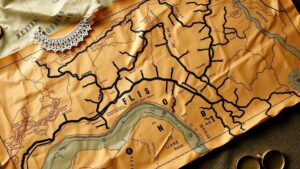Locating Forgotten Storage and Vault Areas in Historical Urban Sites
Locating Forgotten Storage and Vault Areas in Historical Urban Sites
Historical urban sites often hold secrets beneath their surfaces. Among these secrets are forgotten storage areas and vaults that can illuminate the past, revealing insights into urban development, trade practices, and societal structures. The process of locating these hidden spaces requires a combination of historical research, archaeological techniques, and modern technology.
The Importance of Historical Context
Understanding the historical context of a site is crucial when searching for hidden storage and vaults. Historical records can provide valuable information on how a city expanded and developed over time. For example, in cities like Rome, extensive archives detail the shift from ancient to modern infrastructures, including the locations of former marketplaces, warehouses, and hidden vaults that were essential for trade and commerce.
- Historical maps, such as those from the 18th and 19th centuries, can reveal the locations of former structures that no longer exist.
- City directories can help determine the types of businesses that were prevalent in specific areas, leading researchers to potential storage sites.
In New York City, for instance, the remnants of the old street grid and historical property records have led to the discovery of vaults once used by early merchants for storing valuable goods, showcasing how researched can link present-day urban environments with their historical counterparts.
Geophysical Survey Techniques
Geophysical survey techniques are invaluable in locating underground structures without invasive digging. These methods include ground-penetrating radar (GPR), resistivity surveying, and magnetometry. Each technique serves different purposes and can detect various materials, making them essential tools for researchers.
- Ground-Penetrating Radar (GPR): This method transmits radar pulses into the ground, reflecting off subsurface structures. GPR has successfully located forgotten vaults in cities like Chicago, revealing remnants from the Prohibition era.
- Magnetometry: This technique measures the magnetic field of the Earths surface and can identify ferrous materials often found in historical storage areas, such as ironclad doors or metal storage fixtures.
In one notable study, GPR was utilized in a Parisian neighborhood known for its rich history, uncovering evidence of underground storage facilities previously thought to be lost to time.
Archaeological Excavation and Exploration
Once potential sites are identified through historical research and geophysical exploration, archaeological excavation can begin. This phase is essential for verifying the existence of historical storage areas and vaults. Careful stratigraphy and documentation are paramount in these digs to maintain the integrity of the archaeological findings.
- Excavation teams must employ controlled digging methods to uncover layers of history while minimizing disturbance to the surrounding area.
- Artifacts recovered during these excavations can offer invaluable insight into the types of items that were stored in these facilities, contributing to a larger narrative of the citys commercial history.
In Florence, Italy, excavations beneath a former merchant district led to the discovery of a vast network of storage tunnels dating back to the Renaissance, shedding light on trade practices at the time.
Integration of Modern Technology
The integration of modern technology plays an essential role in locating and documenting forgotten storage spaces. Geographic Information Systems (GIS) enable researchers to overlay historical maps with current geospatial data, facilitating the identification of potential locations for further investigation.
- 3D Modeling: Combining GIS data with 3D modeling allows scholars to visualize subsurface features, enabling better planning for archaeological digs.
- Remote Sensing: Advanced remote sensing technology makes it possible to identify anomalies in landscape features, indicating the presence of submerged or buried structures.
For example, in Istanbul, researchers employed GIS alongside historical cartography to uncover buried cisterns and storage vaults, revolutionizing the understanding of the citys water management systems throughout history.
Challenges and Ethical Considerations
While the pursuit of forgotten storage spaces and vaults offers valuable insights, it also presents challenges and ethical considerations. Urban development can complicate excavations, as construction projects often hinder access to potential archaeological sites.
- Plus, there is the ethical responsibility of preserving sites that hold historical significance while balancing community needs for urban expansion and modern services.
- Collaboration with local authorities, historians, and indigenous communities is essential to ensure that excavations proceed with respect and consideration for their cultural heritage.
Perhaps the most poignant example of these challenges can be observed in London, where ongoing construction of the Crossrail project uncovered numerous historical artifacts but also highlighted the need for dialogue among stakeholders about preserving the citys rich historical tapestry amid modernization.
Conclusion: Actionable Takeaways
Locating forgotten storage and vault areas in historical urban sites requires a multidisciplinary approach that combines historical research, advanced technology, and ethical considerations. To engage effectively in this field of study:
- Conduct thorough historical research using archives and maps to understand the context of urban areas.
- Use geophysical survey techniques to non-invasively detect subsurface structures.
- Use careful archaeological excavation methods to verify findings and document artifacts responsibly.
- Adopt modern technology like GIS and 3D modeling to analyze potential sites effectively.
- Engage with local communities and authorities to ensure ethical and responsible exploration practices.
By following these practices, researchers and urban archaeologists can unlock the mysteries of forgotten storage areas, contributing to a richer understanding of our urban histories.

